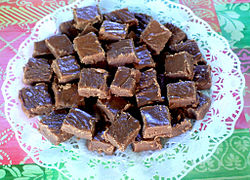 | |
| Type | Confectionery |
|---|---|
| Place of origin | Vietnam |
| Region or state | Bến Tre |
| Main ingredients | Coconut, malt syrup, sugar |

Coconut candy refer to various candies made with coconut or coconut flavorings.
Contents
- About Coconut Candy
- Manufacturing process
- Economic importance
- Coconut candy types
- References
- External links
In Vietnamese cuisine, kẹo dừa is most commonly produced in Bến Tre, using coconut milk and coconut cream.
In the United States, coconut candy was sometimes spelled as cocoanut candy. [1] [2] [3] These included various traditional confections in the United States. Mason Pecan Cocoanut Candy was made in the 1950s in Milprint, Milwaukee. [4] Squirrel Brand made Cocoanut Zippers. [5] There was also a Mason Cherry Cocoanut candy produced in Mineola, New York. [6] Welch's made Cocoanut Candy Bar from Hinde & Dauch. [7] [8] Welch's Cocoanut candy was also produced by the James O. Welch Company. [9]
Sauerkraut candy is made with grated coconut. Grated coconut is often used in various chocolate confections.













